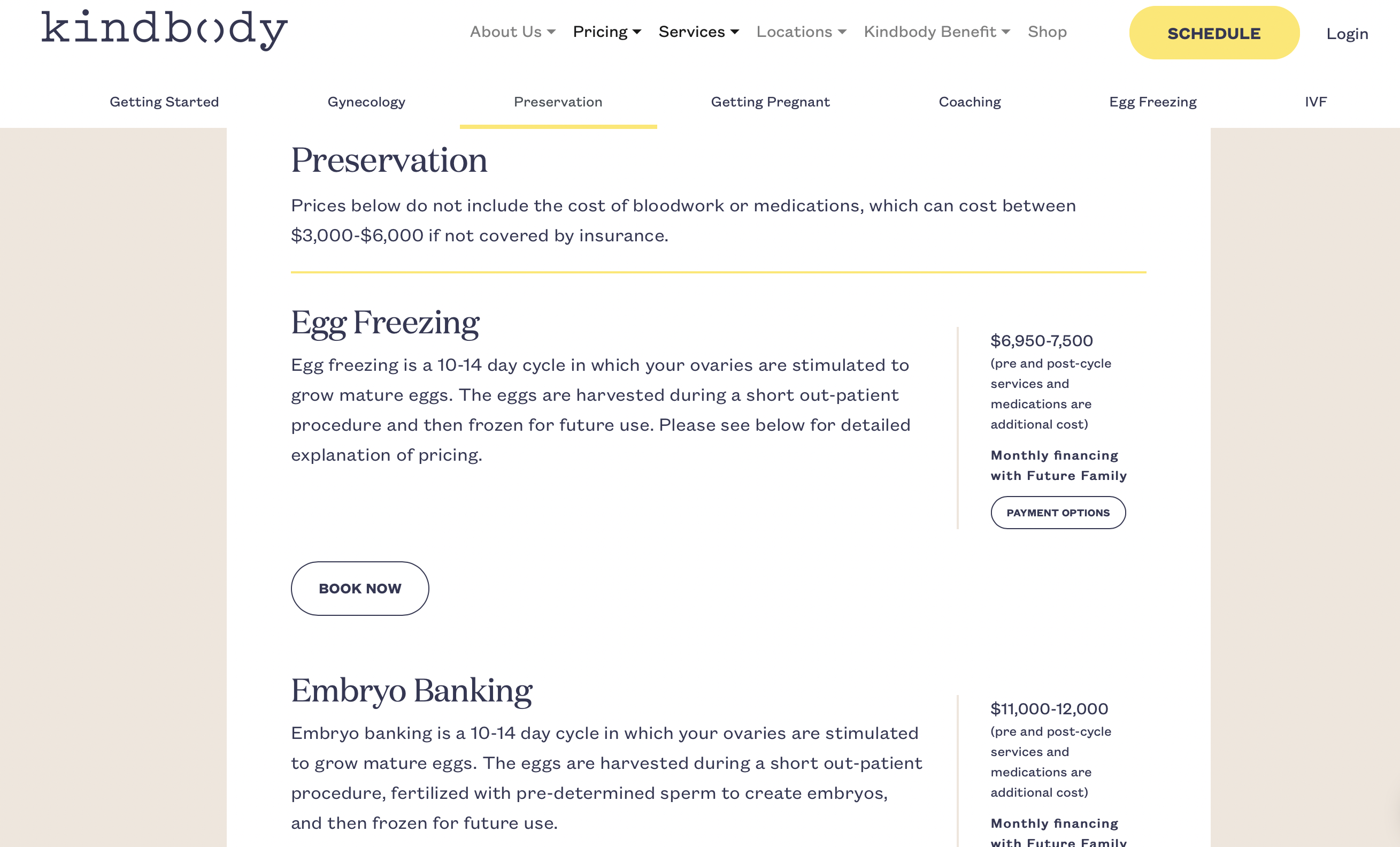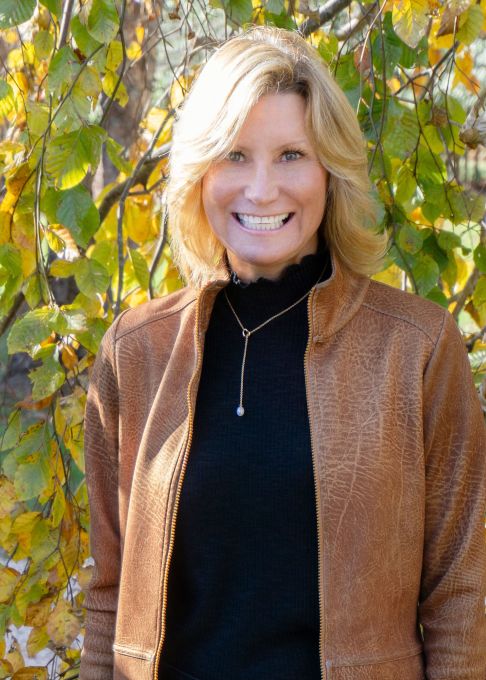One story from The Verge referred to Kindbody as the “SoulCycle” of fertility, pointing out that it sells fertility services and “empowerment” to 25-year-olds. It’s kind of a stretch, but I can see how the company could be compared to the aesthetic-driven facade of The Wing.
Kindbody isn’t solely selling a dream of belonging, however — there is a large focus on the consumerism of patient care. By concentrating on helping its patients feel like they have agency over their fertility journeys, Kindbody is trying to fit into the lives of those wanting to get pregnant.
“When you build businesses you have to think about how consumers behave today and what’s changed in the last five years or 10 years or 15 years,” Kindbody founder and chairwoman Gina Bartasi said. “And consumers crave and receive content.”
She recognizes how different the space is now compared to when she went through her own fertility journey.
“I think the hardest part is adapting, whether it’s adapting the media or adapting to healthcare,” she said. “You constantly have to have this circle and loop back with your customer and customer behavior and how that’s changed. And in healthcare, of course, your customer is the patient.”
Over the last decade, our lives have changed exponentially due to the easy access to information via social media platforms, and the COVID-19 pandemic only added a feeling of perpetual uncertainty. Businesses shut down for months at the top of 2020, schools have oscillated between mandating physical attendance and holding virtual classes nationwide, and offices that once forbade remote work have been introduced to hybrid setups like “hoteling.”
“The majority of patients need flexibility in their calendars,” Bartasi said. “I think, historically speaking, in health care, the patient did whatever the doctor did, whatever the doctor told them to do, and at Kindbody the patient is in charge, not necessarily the doctor.”
You can see this approach in nearly all of Kindbody’s services. Not only does Kindbody want to cater to how its potential patients carry on their lives, it wants them to have a familiar experience as well. Open Kindbody’s website, and you’ll find a templatized, user-friendly landing page with photos of well-designed offices and links to its social media. It’s a familiar look for the 2020s at this point, and that’s intentional.
At the end of the day, you can have the best technology and the best data, but [patients] are still at home crying; it sucks and [they] can’t get out of bed in the morning. Barbara Collura, president of Resolve
With both B2B and B2C income streams, this company is trying to significantly disrupt the women’s healthcare space by focusing on educating, helping patients feel cared for and offering solutions to major pain points through employer-provided benefits.
As Bartasi mentioned in part 1 of this TC-1, she felt like she was treated as a subordinate to the doctor throughout her fertility journey, and her team at Kindbody has put in a lot of work to avoid that.
“It’s really a broken system”
Thanks to the nature of their relationships with the space, both Bartasi and Dr. Fahimeh Sasan, Kindbody’s current chief innovation officer and an experienced board-certified OBGYN, are familiar with the challenges of the fertility journey from two different perspectives — the patient and the provider. They found that the overarching challenge, which ultimately makes every step of this process more difficult, is the fragmentation of care.

Dr. Fahimeh Sasan, Kindbody’s chief innovation officer. Image Credits: Kindbody
“It’s really a broken system, and it’s a system that in no way, shape or form is based on proven human health nor on being proactive,” said Dr. Sasan. “It’s a 100% reactionary system. I was taught that you wait for a woman to prove that she’s not fertile and she has to prove her infertility diagnosis before you start doing testing and see if that’s what the problem may be.”
This reactionary approach is something she’s always felt needed to be corrected. She offers examples of how other ailments or potential health problems are addressed with the aim to prevent rather than cure.
“You do stress tests so that someone doesn’t have a heart attack. We do mammograms to detect breast changes before someone has breast cancer.” But when it comes to infertility, patients have to prove they are experiencing it before it can be addressed. She believes that the teaching and, subsequently, the care, have not caught up with the technology available for patients.
“If you think about the advancements that have been in this field, whether it’s the first egg-freezing or hormone-testing, like for the Anti-Müllerian hormone, and even the capabilities of ultrasound and sonogram, the teachings haven’t changed.”
Patients having to “try” for a year before proving they are infertile and need services not only adds additional time to an already sensitive (and time-sensitive) process, it doesn’t align with the journey of many people using fertility services. How do members of the LGBTQ+ community try for a year? How do the growing number of single moms by choice try to conceive for a year before qualifying for fertility care?
With this experience in hand, Bartasi and Dr. Sasan concentrated on ensuring that Kindbody is focused on centering patient needs.
“We believe very much in the consumerism of healthcare, and what that means is you have to build healthcare around the consumer,” Bartasi said. “We think that the LGBTQ+ population has been historically left out of healthcare. So, we intentionally reach out to underrepresented communities to try to make them feel at home and nurtured.”
To change the system, first change yourself
“A lot of people in general have white coat anxiety. Going to the doctor’s office is anxiety-provoking and having a speculum exam is gross and awful for some,” Dr. Sasan said.
This insight has helped shape what Kindbody patients see — or won’t see — during their visits. For example, all of the doctors at Kindbody are women, because in a survey Kinbody did, they found more than 80% of patients prefer a female doctor.
“None of our women doctors wear white coats, there are no medical degrees on the walls, and none of our doctors have offices,” Bartasi said.
“Even just the aesthetic of creating clinics is typically attached to the doctor,” Dr. Sasan said. “I come from an academic institution where every doctor literally had a square mahogany desk. He sat behind it and everybody had the same bookcase that had all these dusty books.”
The company has taken steps to intentionally strip its premises of that stereotypical stuffy look. Taking the long view, the team sat down and went over everything to make the atmosphere more welcoming, right down to details such as giving tables in exam rooms rounded edges to make them more appealing and remove the head-of-the-table hierarchy.
“An angle says, OK, there are hard edges. We don’t want anything, conceptually, or from an aesthetic standpoint to you, the patient, to be a hard corner, 90-degree angle edge,” Bartasi says.
Dr. Sasan added: “We wanted it to be a blank space for the patient that says, ‘I’m here to help you on this journey.’”

Kindbody clinics’ interiors are designed to evoke a feeling of a wellness center rather than a medical facility. Image Credits: Kindbody
To spearhead this change, the company brought on board the founder of Exhale Spas, Annbeth Eschbach. She had built Exhale to have a boutique feel with a more accessible price point.
Eschbach, now CEO of Corporate at Kindbody following its merger with Vios Fertility Institute, never wanted to leave Exhale, but after going through a challenging and expensive fertility journey, she reconsidered when she saw what Bartasi and the initial team at Kindbody were building.
“What I got excited about, and what Kindbody is actually doing is, rethinking and delivering an experience that is by the patients, for the patients, right through the lens of the patient because we’ve been there,” Eschbach said.
Playing for the long term
Kindbody’s marketing spans a plethora of content initiatives that aim to educate as a way to build its brand, right from newsletters and health blog posts, to news about new medicine and Q&As with experts.
At its core, it is content marketing 101: Build trust in the visitor and ultimately convert them into a customer. Kindbody also uses price transparency as a tool to convert — the price for every service is displayed clearly so potential patients can price out the journey they may be interested in taking.
Other fertility service providers also let you check out their pricing, but I haven’t found any that do it as completely as Kindbody does, and none provide the same kind of 360-degree care.

Kindbody’s website clearly displays pricing for its services.
“We approach this from a whole personal care [point of view] and try to deliver transformational healthcare — something that’s holistic, proactive, integrated and personalized. We want to curate treatments and products that click with each person’s journey, because everyone’s journey is so different,” Eschbach said.
In addition to the OBGYN care and fertility services, Kindbody offers holistic care options, mental health services and nutritional coaching.
“We’ve put together the best-in-class specialty providers — mental health therapists, nutritionists, surrogacy, donor adoption coaches, postpartum and return-to-work coaches, physical therapists, doulas, Eastern medicine specialists, lactation consultants — and these are coaches that are specific to fertility,” Eschbach said.
“All these initiatives to provide easy access to specialists, empowerment and creating a sense of community through their online channels are aimed at reducing the stress and isolation patients may feel,” she continued. “It also helps drive demand. We think that this is the kind of thing that will certainly help you feel like you’re part of a village.”
Addressing oft-ignored problems
This in-between care can be crucial, as it’s often unaccounted for in the fertility journey when care is fragmented and patients have to seek out services on their own. In a recent study by Fertifa, 61% of people surveyed found infertility more stressful than divorce.
Barbara Collura, president of the nonprofit organization Resolve, which supports people experiencing infertility, said mental health services are as important as reproductive care and medication in the fertility journey, and providers and employers offering fertility benefits should recognize that.
“At the end of the day, you can have the best technology and the best data, but [patients] are still at home crying; it sucks and [they] can’t get out of bed in the morning,” she said. A lot of people come to Resolve searching for a sense of community, as well as information about the actual medical processes, Collura added.
Eschbach illustrates the stressful and time-consuming side of the process: “You’re constantly on the phone trying to get answers,” she said. “You’re not able to book online, and everything is fragmented. You’re sent out for this and you’re sent out for that, and you have all these questions. You don’t know who to go to, and when you finally get to see your doctor, it’s for one quick meeting. It makes you very insecure and nervous. In traditional care, it’s kind of this overlooked aspect. We believe it’s number one. The majority of patients are stressed, and it’s a lot of mental pressure.”
This is why Kindbody pays special attention to patients’ mental health throughout their process.
“We introduce it everywhere that we can. We make it available in the patient portal, on the website, through our providers at all of our clinics,” Eschebach said.
“On our intake forms, every patient is asked specific questions about their mental state so that we have a sense, and flag and support certain patients that clearly are going to need it sooner than others. There are lots of different doors that you can choose to go through, and there are different touch points, whether it’s the clinicians who make the suggestion, whether it’s in the patient portal, or whether you as a patient reach out on your own through the website.”
Because patients have access to such a variety of specialists, all Kindbody providers have access to patient records through the portal. “We’re big believers in ending the fragmentation of care. We want you or a patient to go through one door and have access to everything that you need to have a successful outcome,” Eschbach said.
The long-term benefits of inclusivity
Reducing fragmentation has also allowed Kindbody to lower prices. “We have intentionally utilized technology and our own proprietary EMR and patient portal to bring prices down, because we’ve replaced humans answering phones with technology,” Bartasi said.
This technology has enabled Kindbody to offer online appointment registration and management through its own portal without having to leverage a third-party service like ZocDoc.
This focus on access doesn’t just extend to care. “We intentionally reach out to underrepresented communities to try to make them feel at home and nurtured,” Bartasi said.
Today’s families look much different than they did in the past. “You’ve got same-sex couples, single moms by choice, LGBTQ+ — all these people that fall under that umbrella are not getting equal treatment,” Eschbach pointed out.
“We have an entire generation — especially if they’re under 35 — of the LGBTQ+ community that expect to be parents. It’s much different than older generations that didn’t even expect to get married,” Collura added.
Fertility services are expensive and typically focus on heterosexual couples attempting to conceive, but people who don’t identify with a heteronormative lifestyle are often ignored. Kindbody addresses this through its portal, which enables each patient’s journey to be customized based on their path.
The clinic’s proprietary electronic medical record, which it calls KindEMR, includes a practice management system, CRM, medication adherence, and decision support customized to each user’s path.
“Our patient portal is personalized to the individual patients’ needs. So an egg-freezing patient is going to have a different journey than a heterosexual couple who will have a different journey than a homosexual couple,” Bartasi says.
Fertility patients have diverse needs, and their experience on the portal reflects that. An LGBTQ+ patient won’t be asked the same questions or be given the same information as a heterosexual couple because their fertility journey is biologically different. When patients sign up, they include how they identify and the services they’re leveraging. This personalization continues throughout patients’ journeys, both during visits and through the portal.
“A same-sex couple that’s women need a sperm donor. For same-sex men, they’ll need a gestational carrier and an egg donor,” Bartasi offers as an example. “In our patient portal, depending on when you create your account, if you’re an egg-freezing patient, we’re not going to ask about your husband’s or your partner’s sperm motility, as there isn’t necessarily a partner. It’s personalized to the individual patient’s needs.”
The patient portal also offers access to each patient’s personalized care plan, medication instructions and tutorials. This is paramount, as Kindbody has also seen a shift in what their patients’ needs are as they expand and collect more data through the proprietary system.
“More than 90% of our patients were egg-freezing patients when we started. They were young egg-freezing patients. Today, about half of our patients are egg-freezing and half are for IVF.”
Within a traditional practice, doctors typically come together to share patients’ journeys and consult each other on care. Kindbody’s unified database and EMR technology lets all of its providers and patients make data-driven decisions in real time.
The final outcome is an inevitable part of the fertility space, but obviously only tells part of the story. People are leveraging these services for one outcome — a baby. Kindbody says its customized care and intention to make the process easier for a wider range of patients is affecting outcomes for the better.

Kindody’s CEO of corporate, Annbeth Eschbach. Image Credits: Kindbody
“One of the things that Kindbody is able to demonstrate is that we have very high success rates relative to average — an important 10 or 12 points at 72%. We have a 96% single embryo transfer rate, which is huge,” Eschbach says.
It’s not common knowledge that clinics’ success rates are tracked by the U.S Centers for Disease Control and Prevention and made publicly available. Typically, in addition to their own research or recommendations from friends and family, an OBGYN will offer infertility clinic options, but not much beyond that once they’ve concluded that this is their patients’ next step.
“OBGYNs are not necessarily going to tell the patient, ‘Hey, you know, when you do your research, here’s where to check things out,’” Collura pointed out. She wishes more patients knew to look for such information, despite recognizing it is not the end of the road.
For Kindbody, the stats are great for new patients and demand, but they’re also very attractive when it’s selling its benefits solutions to employers.
“If you’re an employer and you have 100,000 bellies that are pregnant and a bunch of them get fertility care and have twins, your NICU costs and your maternity costs are sky high,” Eschbach explained.
Higher success rates and healthier patients mean lower costs for employers and happier employees, but companies realized they had more to gain, and contribute, from partnering with Kindbody.
“What was really wonderful and surprising for me to see and hear firsthand, is that what resonated with a lot of the employers was something beyond that, which is diversity and inclusion,” Eschbach said.
Some legacy benefits plans require patients to try for a year in order to qualify for fertility services. Eschbach said, “If you’re same-sex, you can try all you want and you’re not going to get pregnant. I think the plans are coming around, but that has been a huge roadblock and why the benefits have not been equal.”
Kindbody lets self-insured employers customize plans for their teams that include surrogacy and adoption to ensure equal benefits can be offered for different families.
“That was something we heard loud and clear: Employers are trying to do what they can for D&I,” Eschbach said.
“We believe that we can improve access by opening more clinics serving patients at a 20% to 30% lower price because of our technology,” she said. “And here’s the big kicker, because we are selling directly to employers, once you provide an employer-sponsored benefit, you’ve now really opened the door to access.”
Tackling the “Shake Shack problem”
While Kindbody’s high-quality branding of its services may have raised a few skeptical eyebrows, the company is seeing solid results. In fact, as we saw in part 1, bankers felt Kindbody is having the same problem that the restaurant chain Shake Shack faced when it launched — it couldn’t build fast enough to handle the demand.
“We’ve almost more than tripled our revenue year-over-year in 2020, and we’re doing the same thing this year,” Eschbach told me in late 2021. “We have our foot on the gas pedal and aggressive goals, in terms of patient volume, revenues, as well as unit growth. Then the second big piece of the business, besides the clinics, the providers and the clinic growth, is enterprise.”
Kindbody has taken concrete steps to increase its presence since then. The company announced it had acquired Vios Fertility Institute, a network of fertility clinics, in February 2022. “More and more employers are specifically asking for Kindbody. We had to grow our footprint much faster than initially planned, which led us to the acquisition,” Bartasi told me recently.
“Today, more than 80 companies offer Kindbody’s fertility and family-building benefits solutions to their employees, covering more than 450,000 lives. Employers want a member-centered healthcare experience, and both Vios and Kindbody share the focus on patient satisfaction, as well as above-national-average success rates,” she said.
The company says the merger increases its valuation to $1.2 billion, and it will increase its clinic count from 12 to 26 by the summer, including in Illinois, Michigan, Missouri, Oregon, Washington and Wisconsin. By the end of the year, Kindbody plans to transform 10 more of the Vios clinics, bringing its clinic count to 36.
Patients want healthcare to be easier, and Kindbody has the technology to make it happen, particularly when it comes to family building and topics that society has not afforded the space for conversation, education or equal care.
These topics, however, are still very taboo. Culturally, as a country, we aren’t even in agreement that child-bearing people should all have autonomy over their bodies, particularly around what to do with an unwanted pregnancy, and there is little uniformity in what we teach young people about sexuality and reproductivity.
As we’ll see in part 3 of this TC-1, the tech and science may be here, but there’s still a long way to go.
Kindbody TC-1 Table of Contents
- Introduction
- Part 1: Origin story
- Part 2: Business and marketing
- Part 3: Wider issues
Also check out other TC-1s on TechCrunch+.
